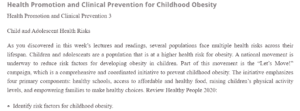Health Promotion and Clinical Prevention for Childhood Obesity
Risk Factors for Childhood Obesity
The factors that put children at high risk of being obese include a diet with high calories, physical inactivity, and sedentary behavior. The consequences of the high-risk factors are influenced by age, sex, characteristics of the family, style of the family, style of parenting, and lifestyles of parents. Environmental factors, including school policies, demographics, and parents’ occupation, also influence eating and activity patterns (Weihrauch-Blüher & Wiegand, 2018).
Adolescent vs Childhood Obesity
There is no significant difference between childhood obesity and adolescent obesity. The risk factors for obesity in adolescents include genetics, lack of physical activity, and diet intake with high-calorie content. The only difference between adolescent and childhood obesity is that childhood obesity occurs in children of high economic status since they may have access to a good life and be sedentary. Adolescent obesity is associated with low economic status families since children from such families may not have access to healthy food or the right places for exercise activities (Lee & Yoon, 2018).
Objectives That Will Combat Childhood and Adolescent Obesity
The objectives will include ensuring that nutritious meals are given in and around schools, increasing the number of caregivers who will measure patients’ BMI, ensuring that education on nutrition and weight is provided and eliminating low food security in children.
Roles of Nurses
Nurses form an essential point of contact with patients. They have a critical role in helping in combating childhood and adolescent obesity. Nurses can formulate educative programs that inform the children and the youth about proper nutrition and exercise. Nurses can also measure the BMI of patients who come to the hospital, which will help screen people at risk for obesity. Nurses can advise patients on appropriate diet and exercise that help with obesity.
References
Weihrauch-Blüher, S., & Wiegand, S. (2018). Risk factors and implications of childhood obesity. Current obesity reports, 7(4), 254-259.
Lee, E. Y., & Yoon, K. H. (2018). Epidemic obesity in children and adolescents: risk factors and prevention. Frontiers of medicine, 12(6), 658-666.
ORDER A PLAGIARISM-FREE PAPER HERE
We’ll write everything from scratch
Question 
Health Promotion and Clinical Prevention for Childhood Obesity
Health Promotion and Clinical Prevention 3
Child and Adolescent Health Risks

Health Promotion and Clinical Prevention for Childhood Obesity
As you discovered in this week’s lectures and readings, several populations face multiple health risks across their lifespan. Children and adolescents are a population that is at a higher health risk for obesity. A national movement is underway to reduce risk factors for developing obesity in children. Part of this movement is the “Let’s Move!” campaign, which is a comprehensive and coordinated initiative to prevent childhood obesity. The initiative emphasizes four primary components: healthy schools, access to affordable and healthy food, raising children’s physical activity levels, and empowering families to make healthy choices. Review Healthy People 2020:
- Identify risk factors for childhood obesity.
- Do the risk factors differ and how do they differ between children and adolescents?
- Identify objectives that will combat childhood and adolescent obesity.
- Provide suggestions on how community health nurses can contribute to these national health objectives and accomplish the goal of decreasing obesity among this population.
